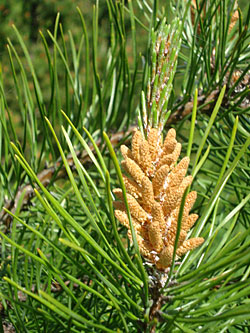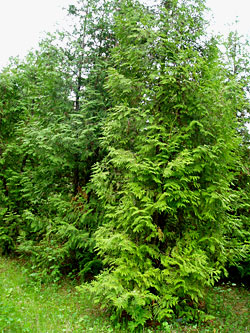
COLLECTION FUND: ARBORETUM
Forming of the collection of woody plants started in 1969. Taking into account research results of other botanic gardens and arboretums situated on the European North and bordering regions with temperate climate, a list of planned tests was designed. This list included 1200 species of trees and shrubs related to 134 genus of 44 families.
For the period since 1969 to 1978 the most part of the plants from the designed list was involved in introduction trials. For that, there were used 5300 samples of nursery material obtained from different parts of the country and from abroad.
To 1980 forming of the collection was almost completed. At that time its composition included 919 wooden species represented with 1780 specimens of different geographical origin. The most part of them was planted in the arboretum.


In succeeding years composition of the collection reduced significantly. This was forwarded with specific soil-climatic conditions of the North and also with lack of opportunities of carrying out agrotechnical maintenance and increase of the collection during the following years.
At present time the collection of trees and shrubs numbers 625 species of 74 genus of 32 families. They are presented with 1129 specimens (6828 plants) of different geographical origin (Europe, Siberia, Far East, Central Asia, and North America).
The Arboretum where the garden`s collection of wooden species is concentrated consists of 2 sections: Systematic Sections, on 32 sites of which plants are arranged predominantly according to principle of botanic affinity (families and genus groups), and a Geographical Sections, with sites of European, Central Asian, Manchurian and North American floras.
The following genus are represented in most abundance: Lonícera (51 species), Rosa (47), Crataegus (37), Spirea (34), Ribes (25), Betula (28), Berberis (28), Salix (24), Sorbus (28), Populus (22), Malus (17), Picea (17), Pinus (15), and Larix (14). Different ornamental forms and varieties are also grown. Also there are rare for the northern conditions species.
The most dominated life form in the collection is shrub, which is associated with their adaptation to the Northern conditions.
The most part of specimens entered generative stage and produces viable seeds of high quality.
All plants in the collection were registered by samples. Phenological observations of plants are carried out regularly. Winter hardiness, flowering and fruiting abundance are assessed annually. Also peculiarities of their growth are studied.
According to the results of introduction studies, 300 species of trees and shrubs were recognized as promising for cultivation on the European North and 140 species were recommended for northern localities landscape gardening.



